Technology Learning Center
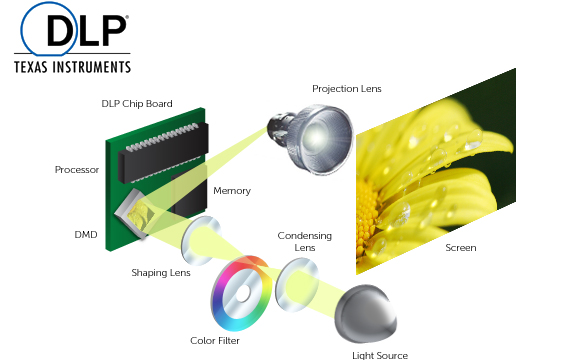
DLP® Chip Technology
DLP chipset-based projectors produce vivid images with digital clarity and precision. The DLP chip uses millions of tiny mirrors to reflect all the colors of visible light to project a digital image onto a screen. DLP technology delivers high contrast ratios and minimizes the gaps between pixels for bright, sharp pictures. Since the light is reflected off of the mirrors, DLP projectors retain color accuracy and deliver stunning images onto the screen. Most DLP projectors are designed to be filter-free, which means lower maintenance and operating costs over time.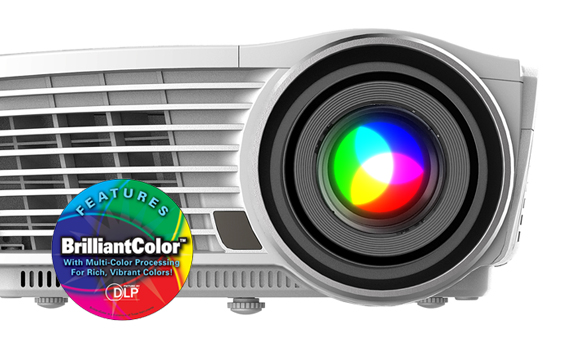
Six is Better than Three In addition to red, green, and blue, BrilliantColor utilizes magenta, cyan, and yellow to create more accurate colors than LCD-based projectors.
BrilliantColor™ Technology
BrilliantColor from Texas Instruments is a multi-color processing technology that produces vibrant images. BrilliantColor technology uses up to six colors, instead of just the three primary colors, red, green and blue, to improve color accuracy and brightens secondary colors. This results in a new level of color performance that increases the brightness of the colors by up to 50% over DLP projectors without BrilliantColor for accurate, true-to-life images.All Vivitek projectors feature BrilliantColor technology.
Learn more about BrilliantColor technology
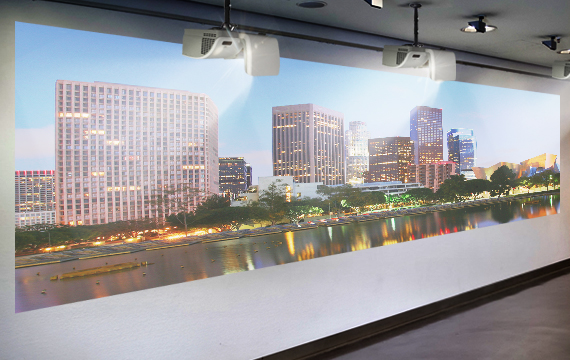
Edge Blending Technology
Edge blending is when two or more projectors are used to create a larger canvas with higher resolution on which the image will immerse audiences. The application can be used in a wide array of applications including architectural mapping, digital signage, simulations, and extreme entertainment. Edge blending utilizes projectors with good optics, color reproduction and brightness uniformity, as well as good black levels for high-resolution displays.Depending on the applications, the projectors can be placed horizontally and vertically, then by overlapping edges of images and using specific test patterns to align the images. This is all done with the projectors' software and optical tuning features. Result will be a large image, higher pixel count and typically a shorter throw distance. Vivitek offers a variety of projectors that have the edge blending functionality to meet the daring imaginations of designers and installers. Edge blending technology can be applied to any Vivitek projector.
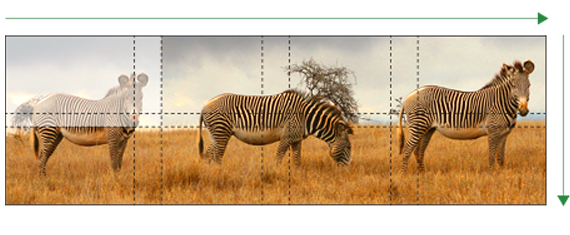
Theoretically, there could be an infinite number of projectors lined up both vertically and horizontally taking full advantage of edge blending. Here's an example with four across and two down, for a total of eight projectors.
Edge blending technology can be applied to any Vivitek projector–using an external blending processor.
Edge blending technology can be applied to any Vivitek projector–using an external blending processor.
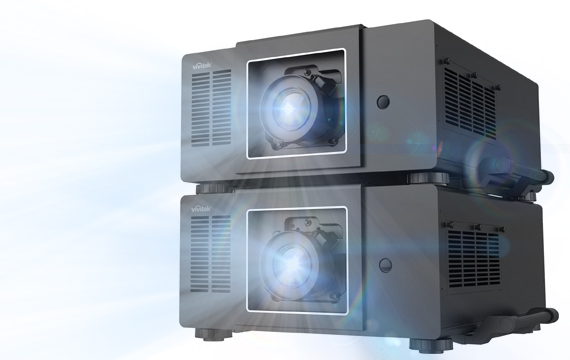
The following Vivitek projectors can be used for projector stacking: DU9000 and D8800 series. Other projectors including, for example, the DU8090Z, D6800 Series, D6000 and D5000 Series can be stacked using 3rd party stacking frames.
Projector Stacking
By stacking projectors dramatic brightness increases can be realized. Another benefit is redundancy in critical projection applications. Projector stacking is a technique used by custom installers, that positions two or more projectors to share a single display. Vivitek's stackable projectors utilize built-in lens shift and geometry correction technology to perfectly overlay individual images for maximized brightness increases. Single chip DLP technology allows for more precise alignment as there is less overall convergence which in turn, allows for greater brightness gains and optimal clarity. Vivitek offers a variety of projectors with stacking capability.The following Vivitek projectors can be used for projector stacking: H9000 and D8800 series. Other projectors in the DU8090Z, D6800 Series, D6000 and D5000 Series can be stacked using 3rd party stacking frame.
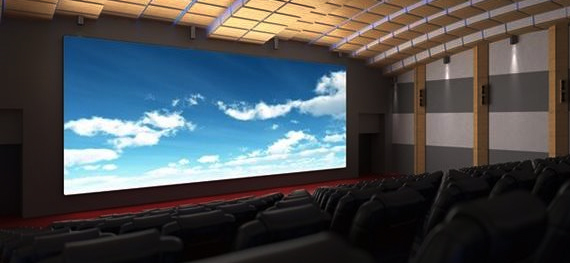
Anamorphic Lenses
While 16:9 is widely accepted as the standard in modern display, the 2.35:1 CinemaScope format is essential for film enthusiasts seeking to flawlessly capture the cinematic experience in their home.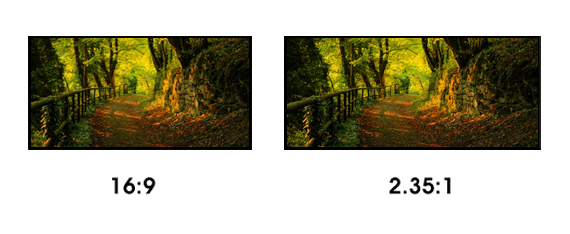
Select Vivitek projectors are compatible with anamorphic lens to optically achieve the widescreen 2.35 support, however, in-built electronic support is also available as a menu/selection option. The electronic widescreen 2.35 support alleviates the need, in many cases, for expensive anamorphic lens and eases installation requirements. A detailed and sharp image is a benefit of using electronic 2.35.
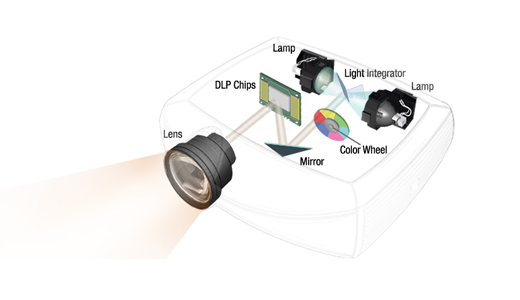
Dual Lamp Technology
For the most part, video projectors operate with a single lamp/bulb. A projection system with more than one lamp allows users to have a projector that is always ready to go. A dual-lamp projector ensures that for presentations and other notable uses that the projector will continue to be operable.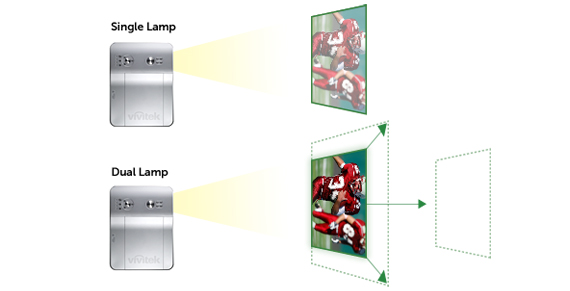
Vivitek projectors with Dual Lamp technology are the D6010 and D6510.
A Vivitek dual-lamp projector can be managed and monitored through a central control room or network, whether harnessing the power of two lamps at the same time for extra brightness or operating one lamp at a time through a single projection path. Having a dual-lamp projector also offers the ability to project content at a longer distance or create larger image sizes beyond what a single lamp can produce.
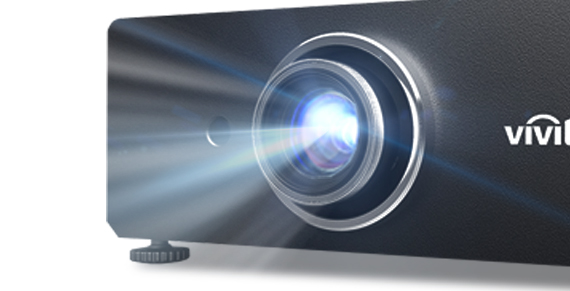
LED Light Technology
LED (Light-Emitting Diode) is a semiconductor-based light source. It is small diode capable of producing a great amount of light. An LED light source is more dynamic than traditional lamps resulting in stunning life-like images with a wider range of color. Vivitek projectors with DynamicBlack and LED technologies have a higher contrast ratio and better black levels due to the ability to adjust brightness levels in bright scenes to almost zero in dark scenes.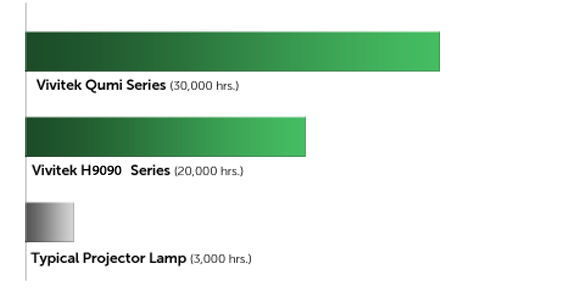
The Vivitek H9080 and the Qumi series of projectors utilize LED technology.
Combined with today's projection technology, LED-based projectors yield a life-span of almost 10 times longer than standard bulb/lamp-based projectors, without having to replace a lamp. LED consumes less power and is free of hazardous materials including mercury and lead, making it an environmentally-friendly solution. Consuming less power also equates to less heat being produced, thus reducing noise level from the projector's fan.
